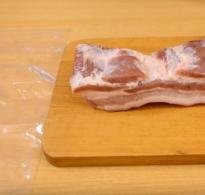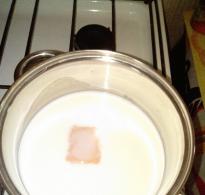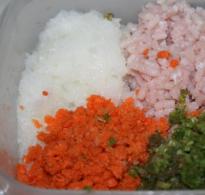The row is poisonous. Tiger row mushroom
Tiger row (poisonous) belongs to the genus Tricholoma. This mushroom has a pleasant “appetizing” aroma and is very similar to edible species rows. Not experienced mushroom pickers They are often poisoned by mushrooms that seem harmless at first glance. But their poison is very strong.
Even in small quantities, poisonous tiger grass can cause severe intestinal and gastrointestinal disorders.
Poisoning of the body is carried out due to the presence of an unstudied toxin in the composition. The attractive smell and taste make these representatives very dangerous. After all, they are not associated with poisonous mushrooms. The first signs of the effect of toxins on the body appear approximately one and a half to two hours (no earlier than fifteen minutes) after eating. The main symptoms include nausea with vomiting and diarrhea.
Much to the happiness of gourmets and lovers of gastronomic delights, tiger row is not very common in our latitudes.
Photo of brindle row
Description of appearance The poisonous row has a fleshy structure and an elastic, dense consistency. Its spore powder is colored White color
and spreads over long distances without problems.
The cap of young mushrooms reaches 12 cm in diameter and has a spherical shape. At a more mature age, the cap of the row becomes flat, with thin curled edges and a slight bulge in the center. The skin of the cap is covered with peculiar scales, which are darker in color than the rest of the body of the mushroom. Most often there are specimens with an off-white, gray, white or gray-white, blackish-gray or light blue shade of the cap.
The width of the plates also reaches 12 cm. They are jagged in structure, quite sparse and fleshy. Young plates have a whitish tint, often with yellow or green splashes. In some places, watery drops appear on mature mushrooms. Tiger row grows on tall (up to 15 cm) medium-wide (2-3.5 cm) legs. The shape of the leg is solid, ideally straight, less often - widened towards the base. U young mushroom
the surface of the stalk is slightly fibrous and almost bare. The color scheme of this part of the row varies from white with an ocher tinge to an ocher-rusty hue.
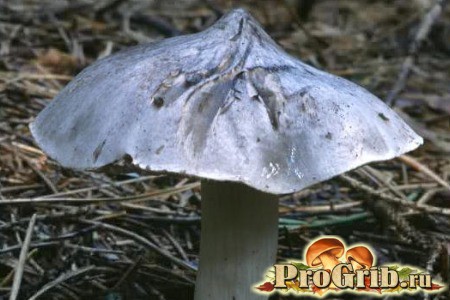
You can get poisoned by this mushroom even from not large quantity
Ground mushrooms from families Tricholomaceae (rank and file) And order agaricaceae. And, actually, rows also called some mushrooms from other genera of the same family. All of them belong to fairly common, but, alas, poorly identifiable mushrooms. This genus of mushrooms received its name for its ability to bear fruit in groups (in rings or in a row).
Ryadovki is a huge genus of mushrooms, which numbers more than 2,500 species such mushrooms, but only a few of them will be of particular interest to mushroom pickers, 5 of which are classified as edible mushrooms and 3rd - to conditionally edible mushrooms.
So, for example, among edible Among the genus of rows of interest are:
and among conditionally edible In the family of rows, the following may be useful:
All other types of row mushrooms can be classified as inedible mushrooms or - poisonous, and some - even to deadly poisonous mushrooms(there are some among them). That is why, mainly only experienced mushroom pickers collect rows of mushrooms for consumption. And if someone is not well versed in these mushrooms, then it would be better (more error-free) not to collect them at all, but to pass by so as not to run into a poisonous specimen.
That is why mushroom pickers who like to collect such mushrooms are afraid, and perhaps in vain, because all of their edible and conditionally edible species are completely suitable for consumption and are even considered mushrooms good quality. And all that may be needed for their accurate recognition and error-free collection is that they need to be memorized well!
Tiger row refers to deadly poisonous mushrooms! And it contains some unknown and deadly toxin, which even in small quantities causes severe gastrointestinal disorders and poisoning. And the symptoms of poisoning with it appear within one and a half to two hours after ingestion and are expressed in the form of severe nausea, vomiting and diarrhea. As first aid, we can recommend immediate gastric lavage with a solution of potassium permanganate followed by decontamination with activated carbon. And of course, you must definitely seek professional help from your doctor, and if things are really bad, then immediately call an ambulance.
✎ Distribution in nature and seasonality
Tiger row, in its family, is far from the most common mushroom and it usually settles in small groups (forming “witch circles”) in coniferous and, much less often, in deciduous forests, on the edges, clearings and clearings, preferring calcareous soils. It is found throughout the temperate zone of the Northern Hemisphere, and lives in the forests of Western Europe, middle zone Russia, the Urals, Siberia and the Far East. Its main fruiting period begins in the first ten days of August and continues until the end of October.
✎ Brief description and application
Tiger row relates to agaric mushrooms. Its plates are quite sparse and fleshy, attached to a tooth, whitish in color with a yellowish or greenish tint, and in mature mushrooms they secrete small watery droplets. Its cap is medium in size, in young mushrooms it is spherical or semi-spherical, and in adults it is semi-prostrate with thin curled edges and a blunt tubercle in the middle, grayish-white or blackish-gray in color with a bluish tint, it can be covered with inconspicuous flocculents. scales of a slightly darker color. Its stem is cylindrical, sometimes thickened towards the base, solid inside, slightly fibrous in young mushrooms, almost bare and smooth in mature ones, white or slightly ocher in color, and with a little rust at the base. And its pulp is dense, grayish-yellowish in color and has a mealy odor. It is strictly forbidden to taste the tiger row, the mushroom is highly poisonous!!!
Mushroom lovers should know that among the large number of varieties of edible mushrooms, there are also very poisonous ones. This is especially true for inexperienced mushroom eaters. Before you go hunting, familiarize yourself with the varieties of mushrooms. Since on your way you may also encounter poisonous mushrooms, for example, tiger row.
Description
Tiger row, also known as poisonous row and leopard row. She received this nickname due to the fact that this mushroom is poisonous and the coloring resembles a leopard or tiger. He is white, and his cap is speckled with black.
The diameter of the cap is from four to twelve centimeters. Those mushrooms that have just begun to grow have a spherical cap. Over time, it becomes convex, with thin, curled edges. In adulthood, the cap begins to crack.
The flesh is white, and on the stem near the cap it begins to turn gray. Has an inconsistent flour smell. The height of the leg is from four to ten centimeters. 2-3.5 centimeters in diameter. It has the shape of a cylinder, sometimes there is a thickening at the end. Young mushrooms are a little hairy, but become bare over time. The color also changes depending on age. From red or brown, to light at the base.
Spreading
The majority of the tiger rowa is found in the Northern Hemisphere. She is a very big fan of sandy and calcareous soils. The row grows together with linden and oak trees. It can be found on the edges and clearings. It is rarely seen in the forest. Mainly grows in large groups. It begins to bloom from August to October; large quantities can be found in September.
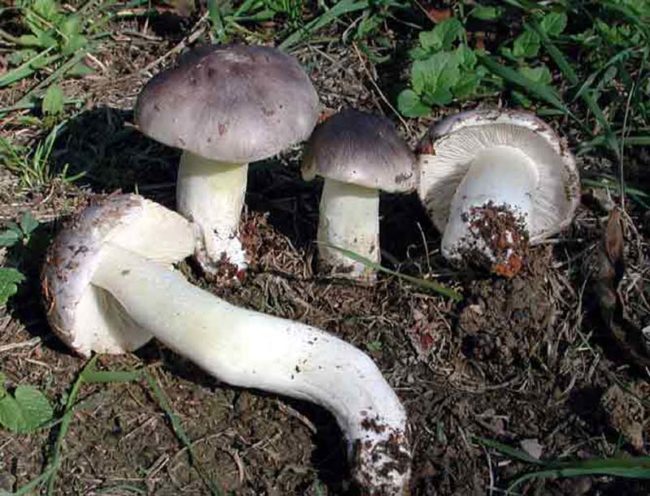
For lovers mushroom dishes, it is very important to know what the rows look like, so as not to mistakenly collect the poisonous tiger row. Depending on the species, these mushrooms have different shapes and colors. It is difficult for non-experienced mushroom pickers to determine which ones are normal and which ones are not.
Poisonous tiger row, can be confused with healthy mushrooms row family. To prevent this from happening, look and study a mushroom such as tiger row, its photo carefully and try to remember. The most important feature of this mushroom is its silvery stem and black cap covered with scales.
Before you start collecting mushrooms, you need to figure out exactly what normal and poisonous mushrooms look like. Fortunately large quantity rows are edible. These include:
- May;
- purple;
- gray;
- yellow;
- green;
- earthy;
- red;
- poplar;
- crowded.
Each of these types is characterized by individual properties and characteristics.
Signs of poisoning and first aid
This poisonous mushroom can confuse even an experienced mushroom picker.
A small amount of eating this mushroom can be fatal. The first signs of poisoning primarily depend on any organism. Poisoning is possible within fifteen minutes to two hours.
Signs of poisoning include vomiting yellow color, problems with the stomach and intestines, diarrhea. Strong thirst appears. Severe abdominal pain, weakness and loss of consciousness. If you do not see a doctor in time, it can be fatal.
During first aid, you need to urgently rinse your stomach. Can be a solution of potassium permanganate, sorbent or activated carbon. When the first symptoms appear, immediately call an ambulance.

